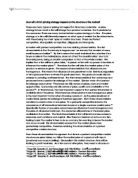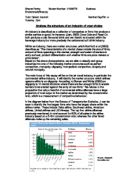Forms of collusion
There are three main forms that collusion between firms can take: cartels, secret agreements, and tacit collusion. Each type will be discussed here one by one.
Cartels
Oxford dictionary provides the following definition of a cartel: “a national or international association of independent enterprises formed to create a monopoly in a given industry” There are many varieties of cartels.
Full cartel is behaving very much like monopoly, controlling all aspects – price, output, investment, product mix and profits. Less complete cartel, often called the marketing cartel controls all its members’ sales and revenues (Shepherd (1979), p307).
The most well known example of cartel is the Organisation of Petroleum Exporting Countries (OPEC). It is an international organisation consisting mainly of oil-rich Middle East Arab countries. It has a significant power in determining the world oil prices by controlling its members’ joint oil production. It first achieved success in 1973 by raising the world oil price from $3 to $11, and then to about $30 in 1979.
The Diamond Cartel, DeBeers, is another well-known example. It has a significant power of control over world diamond industry. Now more than 80% of the world’s diamonds are processed through DeBeers’s Central Selling Organization. In 1981, it flooded the diamond market to punish one of its members for defecting from the cartel and managed to reduce the price form $3 to $1.80
Among all types of collusion cartel is the strongest and most stable one. It is the most powerful in terms of determining the price or any other aspect a cartel controls. For this reason cartels are largely illegal (in Europe by Article 85 of the Treaty of Rome; by Sherman Act in the United States). So, if firms want to communicate directly, they may do so secretly.
Secret agreements
Secret agreements are illegal also, but these agreements are less obvious than cartels. It takes a great deal of effort to detect if a price change, for example is a result of agreement between companies or it is just due to the demand change. Secret agreements are easier to implement than to form a cartel. For this reason, firms have an incentive to make secret agreements to fix the price that would maximise their joint profits or to control any other aspect like quantity, advertisement etc.
One recent example of secret agreements is a case of credit card firms colluding to compete against debit card rivals. Visa and MasterCard actively discouraged the use of rival debit cards to push the use of their own more expensive versions, raising costs for merchants and customers (see Appendix 1). If this anticompetitive behaviour is proved, firms will be heavily penalised.
Another recent example of illegal secret agreement is commission fees fixing by two well-known auction houses. A fine of €20.4 million has been imposed by The European Commission on the auction house Sotheby's for colluding with its rival Christie's. The EU case against the auction houses follows action in the United States where Sotheby's was sentenced to pay $45 million. Christie's escaped both EU and US fines because it provided evidence to European and American investigators that enabled them to prove the existence of the agreement.
Secret agreements are very risky in the sense that once the existence of such agreements is detected and proved, it may result in fines or jail time. In real world, a lot of firms seeking to collude do not want to bear such a risk. Therefore, they have to find some other ways to communicate with each other.
Tacit collusion
Not all collusion involves explicit agreements. When firms are unable to or do not want to communicate directly with each other, collusion may result from tacit agreements. The word “tacit” refers to the fact that these decisions are not negotiated through direct communication, but they arise from implications resulting from firms’ actions.
Tacit agreements may involve signalling of the intent to collude. There can be indirect signals from one firm that can be interpreted as an appeal to collusion. For example, firms can make a series of public statements about the need to raise the prices that form a basis for an actual raise.
When General Electric wanted to slow price competition in the steam turbine industry, it advertised its prices to customers and publicly promised not to sell products below these prices. In addition, General Electric promised to refund customers the difference if they further reduced prices in the future. These actions sent a clear message to General Electric competitors that price reductions would be very costly to General Electric, which is a clear signal of the intent to collude on prices and one that helped reduce price competition in this industry. Both prices and margins in the steam turbine industry remained stable for the next 10 years as General Electric and major competitor Westinghouse learned how to survive together in the industry.
Tacit agreement is a legal way to enforce the collusive outcome, though it is rarely as forceful as cartels or secret agreements. Well, it is not exactly legal, since any (direct or indirect) price fixing, production control, limit production, etc. are prohibited in most countries of the world. In the example above, General Electric’s action resulted in a price fixing for 10 years, which is considered to be illegal. But the fact that General Electric advertised its price to the consumers per se does not violate any of the antitrust laws.
“Tacit collusion between National Power and PowerGen, the dominant generators in England and Wales for most of the 1990s, was widely speculated but was not definitively proven. In the event of a legal determination, the best available evidence is a test of suspicious patterns of collusive behaviour.” Tacit collusion is very difficult to prove once it has been detected. That is why this form of collusion is commonly used by firms in practice. So, we can say that there are not so many legal tools restricting the use of tacit agreements. That what makes it easier for the firms to collude tacitly. But, on the other hand, tacit collusion is the weakest form of collusion because of the absence of any actual agreement (written contracts or verbal agreements) between firms. That makes it more difficult to facilitate tacit collusion. The firms have to build up a degree of shared knowledge and trust to enforce the collusive outcome (Shepherd (1979), p286).
Because of the nature of the agreement, firms cannot apply a system of explicit controls and penalties, though they have to be present.
Conclusion
In this paper we have looked at how in today’s world firms can collude with each other. Clearly, firms want to collude because the benefits from collusion are greater than from the competition. In fact, competition has never been good for the companies. That is why firms want to coordinate their decisions together.
As we have seen, there are three forms of collusion. They are all different in terms of degree of power and stability. On one extreme there is cartel, which is the strongest and most stable form. When forming a cartel, firms establish a ruling body and the system of explicit controls and penalties. That makes cartel stable. In real world some cartel are able to last for a very long time. DeBeers, for example, was established in 1870s and it still operates quite successfully.
On the other extreme there is tacit collusion, which is the weakest form. Because of the nature of the agreement, firms cannot apply a system of explicit controls and penalties. The firms can only make the tacit collusion stable by building up some shared knowledge of what could be done to the “cheaters”. In reality, tacit agreements do not seem to last long. In the General Electric example above, agreement eventually broke up after ten years. Comparing to almost 140 years of DeBeers existence, it is very short.
Secret agreement is somewhere between these two forms. Firms do not establish a ruling body, but explicit controls and penalties can be present.
From the social welfare point of view, collusion is not a good thing. That is why authorities are trying to restrict collusion practice through the antitrust law. Some forms of collusion are easier to restrict than the others. For example, it is now impossible for companies to establish a cartel in developed countries. Where as tacit collusion is commonly used because of the lack of legal tools preventing firms from doing that. Secret agreements are used also, but many firms do not want to bear a risk of being caught. If the existence of a secret agreement is proved, firms engaging in this agreement are heavily penalised. In some sense, the risk of being caught and heavy penalties restrict the use of secret agreement practices.
So, it may be concluded that more powerful and more stable forms of collusion meet greater antitrust restrictions (in one form or another) than those, which are less powerful and stable.
Bibliography
CNNMoney, “Visa, MC in alleged collusion”, [http://money.cnn.com/2002/11/14/news/companies/visa_mc.reut/], November 2002
Dictionary of Law, Oxford University Press, Market House Books Ltd, 1997
“EU fines Sotheby's $A36m for collusion”, [http://www.smh.com.au/articles/2002/10/30/1035683480501.html], October 2002
Lester G. Telser, “Competition, Collusion, and Game Theory”, The Macmillan Press Ltd: London, 1972
Lipczynski John, Wilson John, “Industrial Organisation: An Analysis of Competitive Markets”, Prentice Hall: London, 2001
Luis M., B. Cabral, “Introduction to Industrial Organisation”, MIT Press: London, 2000
Macatangay, Rafael. “Tacit collusion in the frequently repeated multi-unit uniform price auction for wholesale electricity in England and Wales.” [http://www.energyonline.com/reports/Tacit.asp].
O'Regan Sharon, “Tacit collusion”, [http://studentweb.tulane.edu/~soregan/new_page_3.htm]
Schmalensee Richard, Willig Robert, “Handbook of Industrial Organisation: Volume I”, North-Holland: Amsterdam, The Netherlands, 1989
Shepherd G. William, “The Economics of Industrial Organization”, Prentice-Hall: United States of America, 1979
Appendix 1
Source: CNNMoney, “Visa, MC in alleged collusion”, [http://money.cnn.com/2002/11/14/news/companies/visa_mc.reut/], November 2002
Dictionary of Law, Oxford University Press, Market House Books Ltd, 1997
for more details see [http://www.opec.org]
Taken from Luis and Cabral (2000), p132
“EU fines Sotheby's $A36m for collusion”, [http://www.smh.com.au/articles/2002/10/30/1035683480501.html], October 2002
O'Regan Sharon, “Tacit collusion”, [http://studentweb.tulane.edu/~soregan/new_page_3.htm]
Macatangay, Rafael. “Tacit collusion in the frequently repeated multi-unit uniform price auction for wholesale electricity in England and Wales.” [http://www.energyonline.com/reports/Tacit.asp].







